1) History of the Instrument
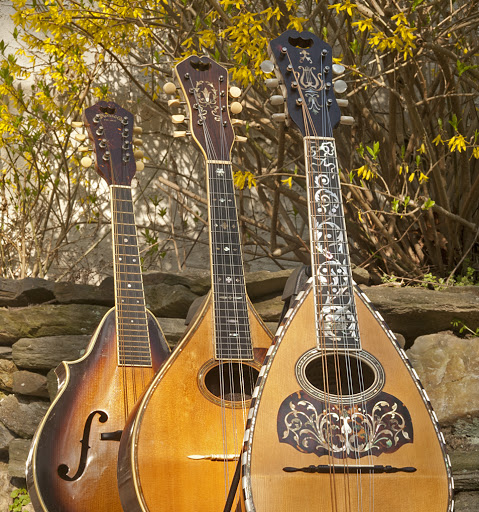
The mandolin can be described as a small, short-necked lute with eight strings that can be plucked or strummed. A lute is a chordophone, an instrument which makes sound by the vibration of strings. It has a body with a teardrop-shaped soundboard, or one which is essentially oval in shape, with a soundhole, or soundholes, of varying shapes which are open and are not decorated with an intricately carved grille like the Baroque era mandolins.
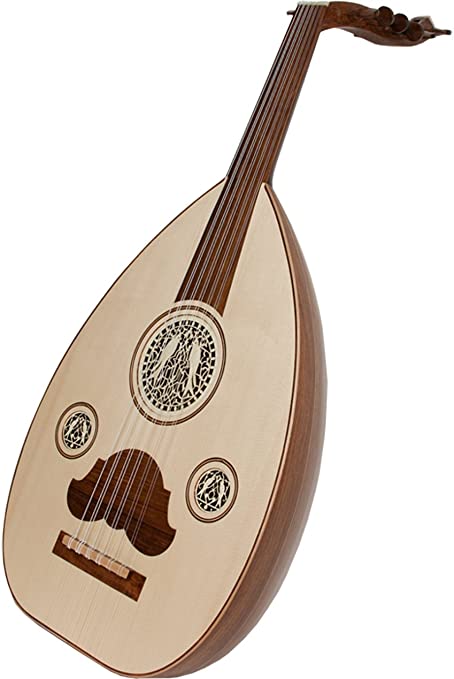
As a descendent of the lute, the mandolin reaches back to some of the earliest musical instruments. They began to appear as early as 2000 BC in Mesopotamia and were fretless. By the 7th century, a folk lute called the oud was in use, and is still in use today. The word, “oud”, is the Arabic name for wood. The oud found its way into Spain during the Moorish conquest of Spain (711-1492), to Venice through coastal trade, and to Europe through returning Crusaders around 1099.
In the 17th century in Northern Italy, the mandolin was made in a form which was smaller and had fewer strings. This was called a mandolino, which means “little mandola.”
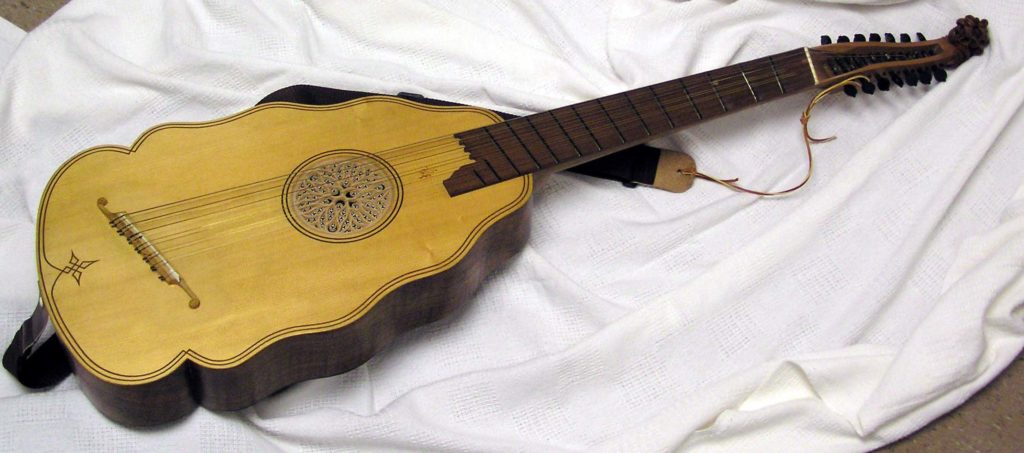

Similar instruments were developed in other countries. Portugal had the bandaline; Greece the bouzouki; the Balkan countries the taburitza; and Russian the balalaika, their national instrument, which was triangular shaped. Stephen Morey’s book, “Mandolin of the 18th century” states that from 1680-1800 there was a large repertoire for various types of mandolin & there’s at least 400 surviving instruments. It was a popular time for mandolin. before it dwindled in popularity in 19th century. Many fewer surviving instruments & repertoire from 1st half of 19th than 2nd half of 18th century demonstrates this. Earliest surviving info about mandolin family is connected with court of Medici—Florence around 1589.
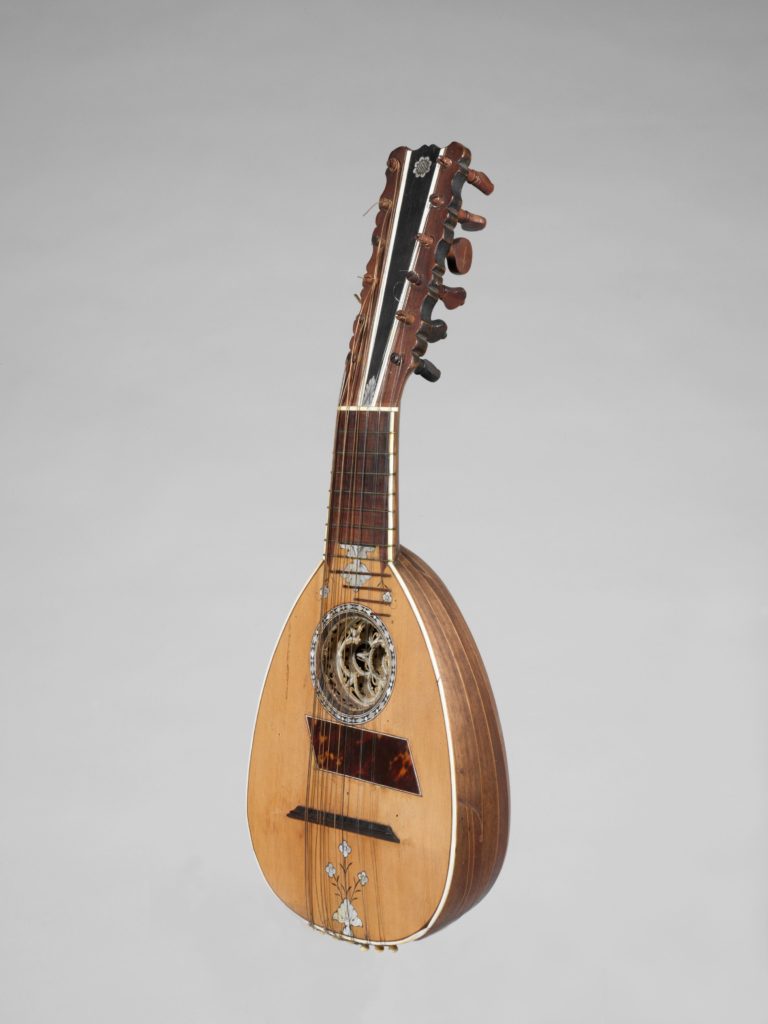
Originally mandolins had six double courses of gut strings (Gut strings are made from the small intestines of sheep) tuned similarly to lutes, and plucked with the fingertips, while the design common today has eight metal strings in four pairs (courses) which are plucked with a plectrum. The latter originated in Naples, Italy during the 3rd quarter of the 18th century.
Many variants of the mandolin have existed. These include Milanese, Lombard, Brescian and other 6-course types, as well as four-string (one string per course), twelve-string (three strings per course), and sixteen-string (four strings per course).
2) Brief Summary of the Era (1890-1910)
By century’s end, American industrial production and per capita income exceeded those of all other world nations and ranked only behind Great Britain. In response to heavy debts and decreasing farm prices, farmers joined the Populist Party. Later, an unprecedented wave of immigration served both to provide the labor for American industry and create diverse communities in previously undeveloped areas. From 1880 to 1914, peak years of immigration, more than 22 million people migrated to the United States. The population in 1880 was a little over 50 million. Along with these new immigrants came their instruments and music of their cultures.
3) Examination of the instrument & its status in the popular music of the era.
Mandolins have a long history, and much early music was written for them. In the first half of the 20th century, they enjoyed a period of great popularity in Europe and the Americas as an easier approach to playing string music. Many professional and amateur mandolin groups and orchestras were formed to play light classical string repertory. Just as this practice was falling into disuse, the mandolin found a new niche in American country, old-time music, bluegrass, and folk music. More recently, the Baroque and Classical mandolin repertory and styles have benefited from the raised awareness of and interest in Early music. Tremolo and fingerpicking methods are used while playing a mandolin.
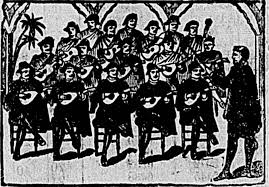
In 1880, a group called, “Estudiantina Espanola Figaro” made up of 15 members with 9 playing an instrument similar to the mandolin ignited a mandolin craze that swept America. They actually played bandolins instead of mandolins, but had a flat back and top, as opposed to the mandolin’s round back and canted top (slightly bent).
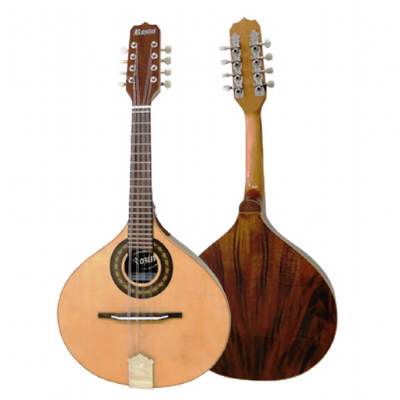
One account stated they played Bandurrias, which are also small, double-strung instruments resembling the mandolin. The bandurria is a plectrum plucked chordophone from Spain, similar to the cittern and the mandolin, primarily used in Spanish folk music. It was a distinctive sound because no other instrument, except guitar and banjo, was played with a plectrum.
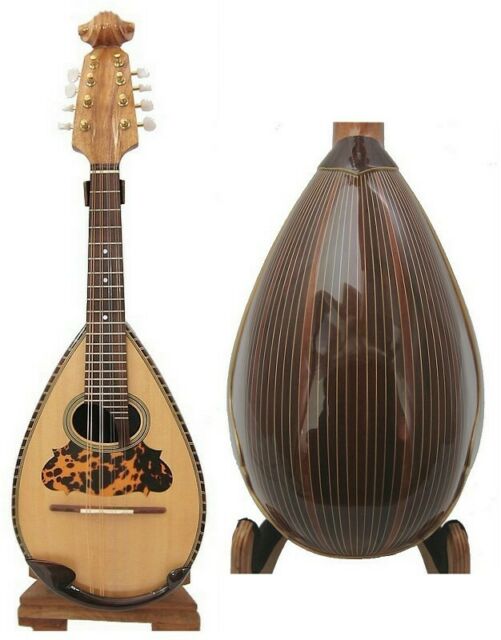
An increase of Italian immigration 1880’s sparked interest in the Neapolitan bowl-back. They had an oval sound hole, canted or bent top, and ribs that formed the back. The ones that came from Northern Italy had a shallower body and gut strings. Those from Naples and southern Italy had a deeper body & metal strings. The Vinaccia & Calace families were the greatest makers of these. Because the majority of Italian immigrants came from this area, most instruments in this country were of this style. The U.S. had the world’s largest community of Italian immigrants by 1908 which is a main reason for the mandolin’s popularity.
These Italians learned mainly by ear because they were self-taught, passing their folk tunes from the homeland down to following generations. They cultivated their music through fellowship with others. Barbershops also helped to spawn this musical tradition. They served as the unofficial school & rehearsal space for mandolin groups.
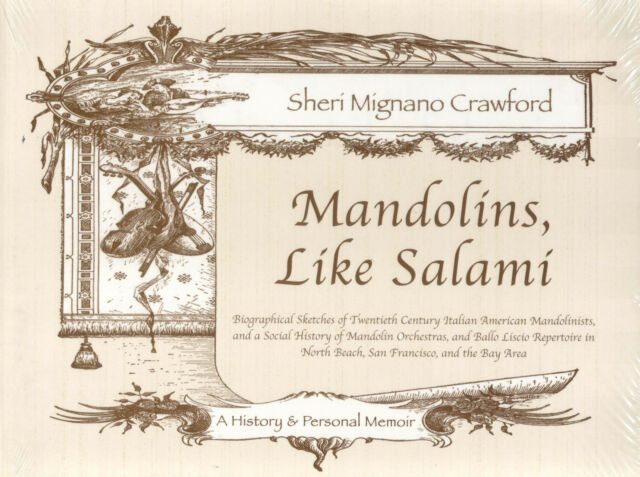
In her book, “Mandolins Like Salamis,” Sheri Mignano Crawford mentions how mandolins, “hung like salamis” in the north beach San Francisco area where she grew up.
The Aurora Mandolin Orchestra, under the direction of Josephine Pelegrinni continues the mandolin orchestra in this area. As her husband Gino who started the orchestra once said, “The mandolin is like a sweet girl talking…with a wide smile.” Mandolins shared parlors with zithers and ukuleles designed to amuse an increasingly leisured middle class.
The success of the Figaro Spanish Students spawned several groups who imitated their musical style and colorful costumes. In many cases, the players in these new musical ensembles were Italian-born Americans who had brought mandolins from their native land. Thus, the Spanish Student imitators did primarily play mandolins and helped to generate enormous public interest in an instrument which previously was relatively unknown in the United States.
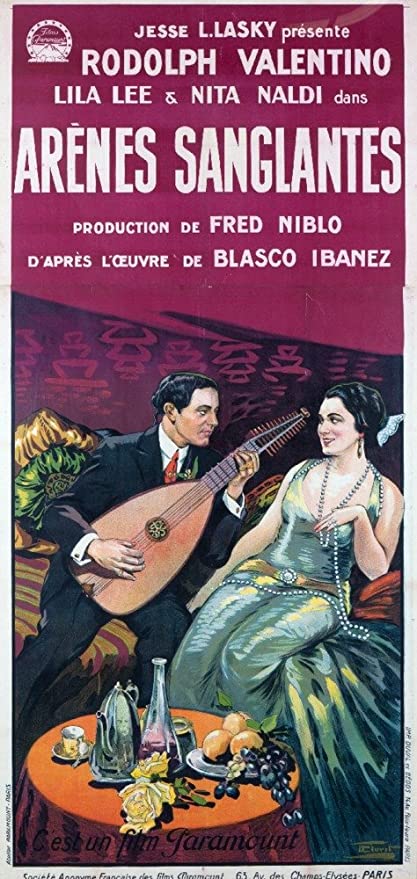
In Eastern cities like Boston, Washington D.C., Philadelphia, & N.Y, it was considered to be fashionable to play the mandolin. Some people who were not so well-to-do would even walk around with mandolin cases in public to give the impression they were really part of “high society.” Most colleges had a mandolin club, as did most sporting & bicycling organizations. In 1888, Kansas City had 100 mandolin clubs & orchestras as mainly social organizations whose principal function was entertaining friends & serenading lady loves. The magazine ”Cadenza,” that ran from 1894-1924, helped elevate the mandolin in America to be above that of their European colleagues in performance & composition. Rudolph Valentino also enhanced the mandolin’s popularity because of its use in his movies swooning young women. Popular music of this time period was ragtime, music with a syncopated, or ragged rhythm.
Mandolins held their popularity from the turn of the century to the mid-twenties. Instruments were marketed by teacher-dealers, much as the title character in the popular musical The Music Man. Often these teacher-dealers would conduct mandolin orchestras: groups of 4-50 musicians who would play various mandolin family instruments together.
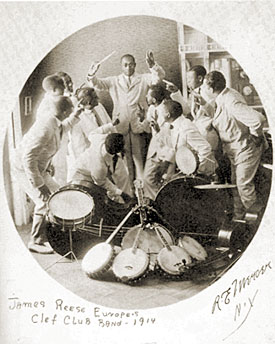
One musician and director who made his start with a mandolin orchestra was pioneer African-American composer James Reese Europe. The instrument was primarily used in an ensemble setting well into the 1930s, although the fad died out at the beginning of the 1930s. The famous Lloyd Loar Master Model from Gibson from 1923 was designed to boost the flagging interest in mandolin ensembles, but with little success.
Lloyd Allayre Loar (January 9, 1886 – September 14, 1943) was a Gibson sound engineer and master luthier in the early part of the 20th century. He is most famous for his F5 model mandolin, L5 guitar, H5 mandola, K5 mandocello, and A5 mandolin.
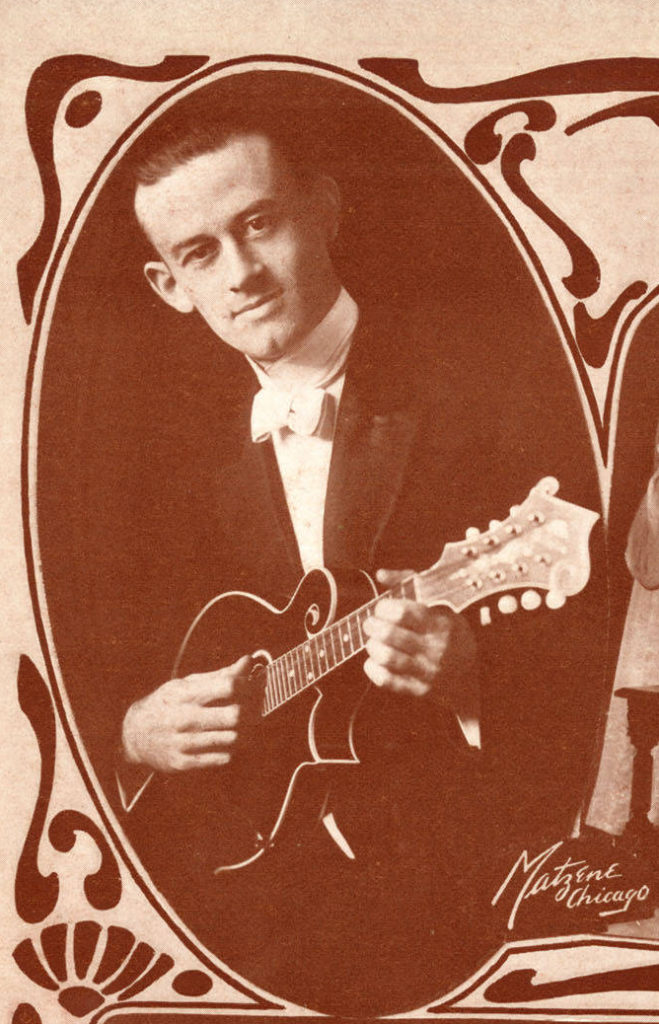
Loar was also a well-regarded performer of music on the mandolin, viola, and musical saw. He travelled the United States and Europe in several different incarnations of musical groups. In one grouping, he performed with his eventual wife Fisher Shipp. One surviving playbill shows that Loar performed in a chatauqua that also included a speech by William Jennings Bryan. Many other groups Loar performed in served as promotion for the Gibson company, whose products Loar endorses in early Gibson catalogs. It has been noted that Loar was a Theosophist and a Vegetarian.
Loar worked for Gibson from 1919 to 1924. His contributions include building the instrument top with F-shaped holes, like a violin; introducing a longer neck, thus moving the bridge closer to the center of the body; and floating the fingerboard over the top, a change from prior Gibson instruments that had fingerboards fused to the top. He also pioneered the use of the Virzi Tone Producer, a spruce disc suspended from the instrument top that acts as a supplemental soundboard.
After leaving Gibson, Loar created and patented an electric instrument with a coil pickup, and co-founded the ViviTone company. He died in 1943.
Orville Gibson (born 1856, Chateaugay, New York) started making mandolins in Kalamazoo, Michigan, United States. Orville Gibson died in 1918 from a tumor in his left scrotum. He was a shoe clerk and amateur guitarist whose first instrument was a 9 string guitar with a violin inspired arch top and back built in 1888. The mandolins were distinctive in that they featured a carved, arched solid wood top and back and bent wood sides. Prior to this, mandolins had a flat solid wood top and a bowl-like back (similar to a lute) made of multiple strips of wood. These bowl-back mandolins were very fragile and unstable. Disdainful of the shape, Orville Gibson characterized them as “potato bugs”. Gibson’s innovation made a distinctive, darker-sounding mandolin that was easier to manufacture in large numbers. Orville Gibson’s mandolin design, with its single-pieced carved sides and a single-pieced neck, was patented in 1898; it would be the only innovation he patented. The Gibson Co. traces its origins to an Orville Gibson lute-guitar dated 1894. The Gibson Guitar Corporation was founded in 1902. Orville’s instruments were “unstressed”—not bent at the face or back like the bowl backs. His tops were carved into self supporting arch shape with backs like a dinner plate—carved around the edges but flat across the center to act like a reflective soundboard. They had wider bodies than bowl backs, and an increased scale length 7/8th” over the standard 13” bowl back, which led to greater string tension which in turn led to greater volume. He developed an “A” style—symmetrical pear shape, and an “F” style which had 3 body points & a scroll on the upper bass bout. Because of these innovations, musicians were willing to pay $50 for one of his compared to a Washburn bowl back at $15. He did an “H” series of mandolas, a “K” series of mandocellos, and a “J” style mandobass. From 1909 on, his instruments were of a very high standard, many of which are much sought after by professional performers today. The Gibson Co. sent field representatives across Am. to encourage sales of mandolins and establish mandolin orchestras and establish, “The Evolution of the Modern Flat-Back” (Orville Gibson). Arguments have gone on since his instruments first appeared on the mandolin scene as to whether they are superior or inferior to the round back mandolin of the day. Compared with an Emberger or Calace mandolin, a Gibson has a larger resonating chamber, longer fingerboard, and considerably more wood in its construction which results in a deeper, more guitar-like tone with a punchy, powerful attack, but fewer high harmonics and less brilliance. Non classical players who perform ragtime, dance tunes, & other non-classical music regarded the Gibson as superior. A great number of American classical players and the vast majority of Europeans thoroughly disliked it, considering it garish and wooden and finding that its long fingerboard made it impossible to play intricate, polyphonic Italian works. One famous classical player, James Tyler, was unimpressed with Gibsons and stated,”My opinion has never changed. They were miniature lumberyards painted up like prostitutes.” The Gibson company, however, marketed its new instruments extremely aggressively by establishing a network of teachers to sell them to pupils, and persuaded leading American players of the day such as Bickford and Place, who had previously used round-back mandolins, to endorse a Gibson model, and also started a campaign against traditional Neapolitan instruments. The company even went so far as to say the round back instruments looked like potato bugs which had been recently devastating the nation’s potato crop. They said they should be swept away like the infestations of the pesky potato bugs. By 1910 the company was making about 3500 instruments a year, mostly mandolins. In 1917 an “A” series model was $27.50 and an “F” model $110. By the end of WWI, Gibson had attained a position of commercial pre-eminence in America which it has retained ever since, except in the classical field, where it seems to still be despised. A side note about Bickford is he has written what some people call the Bible of Mandolin Playing. He did four volumes of his method, all written in treble clef. Along with Valentin Abt, they formed the first American classical plectrum quartet consisting of 2 mandolins, tenor mandolin, and mandocello. This time period also saw a lot of belief in the occult. Bickford’s given 1st name was Myron, but he changed it to the astrological name of Zarh. Madam Blavatsky, Harry Houdini’s spiritualist, was popular during this time. One composition exemplifying this is Halley’s Comet. The Gibson company today, however, is having difficulty staying alive. Talking to an old craftsman/repairman in Gryphon Music in Palo Alto recently, he said they just diversified too much. They had moved from Kalamazoo to Nashville where it expanded its line to include headphones, turntables, & speakers. Bankruptcy reorganization likely means the departure of CEO Henry Juszkiewicz, but the Chapter 11 reorganization is actually a good sign because it means investors are willing to take control instead of liquidating. They will continue to make guitars, selling their building and relocating to a nearby space. Many collections and collectors will preserve the Gibson name. Elvis had a collection of Gibsons used in his films, and BB King had his collection to include Lucille, an inexpensive small-bodied Gibson L-30 arch top.
By 1897, the Lyon & Healy company produced over 100,000 mandolins which comprised well over half of the fretted instrument production, topping guitars and banjos. Prices ranged from $15-$125, from 9 ribs-42 ribs, with elaborate pearl borders, engraved fingerboards inlaid with mother of pearl, and pearl butterfly inlaid into the pick guard. Lyon & Healy boasted, “At any time you can find in our factory upwards of 10K man. in various stages of construction.” From Sears & Montgomery Ward’s catalogs, man. proliferated across the south.
The Charles Bruno & Son company introduced the flat back in 1889 which reduced production costs and were stronger than the round backs. Luthiers, however, didn’t give up on the bowl back. In 1887, George Durkee who worked for Lyon & Healy got a patent for strengthening bowl backs, where he cut grooves in the ribs & installed cross pieces. He abandoned his project inn 1899 & returned to paper lining of the bowl.
The Howe-Orme company produced a guitar shaped mandolin with a hump or ridge down the back. James Back of Ottawa, Canada, had there patent and gave half to the company. In 1897 they joined, but the design didn’t last. The Vega company followed with a ridge design 20 years later. Neil Merrill of Oshkosh, WI, & C.W. Hutchins of Springfield, Mass, developed an aluminum bowl back in 1896. Another innovation came from the Barrows Co. of Saginaw, MI, made bowl backs that introduced “f” holes in 1896. Unfortunately went out of business by 1905.
The mandolin is the soprano member of the mandolin family, as the violin is the soprano member of the violin family. Like the violin, its scale length is typically about 13 inches (330 mm). Modern American mandolins modeled after Gibsons have a longer scale, about 13-7/8″ (352 mm).
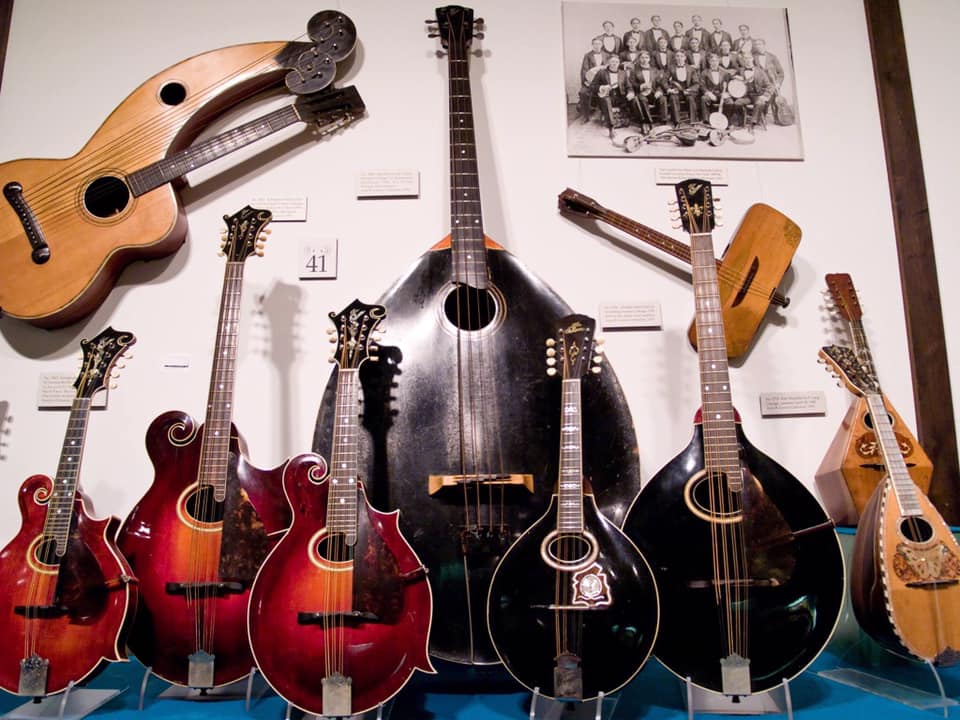
Other members of the mandolin family are:
The mandola (US and Canada), termed the tenor mandola in Europe, which is tuned to a fifth below the mandolin, in the same relationship as that of the viola to the violin. Some also call this instrument the “alto mandola.” Its scale length is typically about 16.5 inches (420 mm). It is normally tuned like a viola: C-G-D-A.
The octave mandolin (US and Canada), termed the octave mandola or mandole in Europe, which is tuned an octave below the mandolin. Its scale length is typically about 20 inches (500 mm), although instruments with scales as short as 17 inches (430 mm) or as long as 21 inches (530 mm) are not unknown.
The mandocello, which is classically tuned to an octave plus a fifth below the mandolin, in the same relationship as that of the cello to the violin: C-G-D-A. Today, it is not infrequently restrung for octave mandolin tuning or the Irish bouzouki’s GDAD. Its scale length is typically about 25 inches (635 mm). A typical violoncello scale is 27″ (686 mm).
The mando-bass, has 4 single strings, rather than double courses, and is tuned like a double bass. These were made by the Gibson company in the early twentieth century, but appear to have never been very common. Reportedly, most mandolin orchestras preferred to use the ordinary double bass, rather than a specialised mandolin family instrument. Calace and other Italian makers predating Gibson also made mandolin-basses.
The piccolo or sopranino mandolin is a rare member of the family, tuned one octave above the tenor mandola and one fourth above the mandolin; the same relation as that of the piccolo or sopranino violin to the violin and viola. One model was manufactured by the Lyon & Healy company under the Leland brand. A handful of contemporary luthiers build piccolo mandolins. Its scale length is typically about 9.5 inches (240 mm).
Other Mandolin forms:
1930 National Triolian resonator mandolin from Lowell Levinger’s collection
1926 Paramount Style A Banjo Mandolin from Lowell Levinger’s collection
Carved (acoustic-electric) and round backed mandolins
Carved and round backed mandolins (Isn’t this line redundant?)
Mandolins come in several forms. The Neapolitan style, known as a round-back or bowl-back (or “tater-bug,” colloquial American) has a vaulted back made of a number of strips of wood in a bowl formation, similar to a lute, and usually a canted, two-plane, uncarved top. Another form has a banjo-style body.
At the very end of the nineteenth century, a new style, with a carved top and back construction inspired by violin family instruments began to supplant the European-style bowl-back instruments, especially in the United States. This new style is credited to mandolins designed and built by Orville Gibson, a Kalamazoo, Michigan luthier who founded the “Gibson Mandolin-Guitar Manufacturing Co., Limited” in 1902. Gibson mandolins evolved into two basic styles: the Florentine or F-style, which has a decorative scroll near the neck, two points on the lower body, and usually a scroll carved into the headstock; and the A-style, which is pear shaped, has no points, and usually has a simpler headstock.
These styles generally have either two f-shaped soundholes like a violin (F-5 and A-5), or an oval sound hole (F-4 and A-4 and lower models) directly under the strings. Much variation exists between makers working from these archetypes, and other variants have become increasingly common. The Gibson F-hole F-5-style mandolins have come to be considered the most typical and traditional for playing American bluegrass music, while the A-style is generally more associated with Irish, folk, or classical music. The more complicated woodwork also translates into a more expensive instrument.
Internal bracing in the F-style mandolins was usually achieved with parallel tone bars, similar to a violin’s bassbar. Some makers instead employ “x-bracing” which is simply two tone bars mortised to each other to cross into an X supporting the top. Some luthiers are now using a “modified x-bracing,” which incorporates both a tone bar and x-bracing.
Numerous modern mandolin makers build instruments which are largely replicas of the Gibson F-5 Artist models built in the early 1920s under the supervision of Gibson acoustician Lloyd Loar. Original Loar-signed instruments are sought after and extremely valuable.
Other American-made variants include the mandolinetto or Howe-Orme guitar-shaped mandolin (manufactured by the Elias Howe Company between 1897 and roughly 1920), which featured a cylindrical bulge along the top from fingerboard end to tailpiece; the Army-Navy style with a flat back and top; and the Vega mando-lute (more commonly called a cylinder-back mandolin manufactured by the Vega Company between 1913 and roughly 1927), which had a similar longitudinal bulge but on the back rather than the front of the instrument.
As with almost every other contemporary string instrument, another modern variant is the electric mandolin. These mandolins can have four (single), five (single) or eight (double) strings.
The mandolin has become a familiar instrument in America’s musical culture today thanks to the efforts of bluegrass music and people like Chris Thile, Even Marshall, and Mike Marshall. Mandolin repertoire ranges across the entire spectrum of musical styles, from classical to bluegrass to jazz, and even occasionally in rock n roll.
Over the past 135 years its popularity has swung back and forth from one extreme to another. From its European roots it came on the American scene in 1880 and became a national craze, eclipsing the banjo and guitar as the most popular fretted instrument. The mandolin orchestra style can be adapted to any kind of popular music to include marches, dances, operatic overtures, and popular songs of the day, and could be easily picked up and learned by anyone.
By WWI, the mandolin dwindled in popularity as American musical tastes changed. Around WWII, the mandolin began to re-emerge from the rural string band tradition of bluegrass music, and from that continuing on to include classical & jazz music.
Sources for the previous information:
The Classical Mandolin Paul Sparks
History of the Mandolin Konrad Wolki
The Mandolin—A History Graham McDonald
Mandolin in America Walter Carter
The Mandolin in America After 1880 and The History of Mandolin Orchestras in Milwaukee, Wisconsin Paul Ruppa
Mandolin of the 18th century Stephen Morey
Mandolins Like Salami Sherri Mignano Crawford
Wikipedia
For Questions or Issues with the website
webmaster@sandiegomandolinorchestra.org
